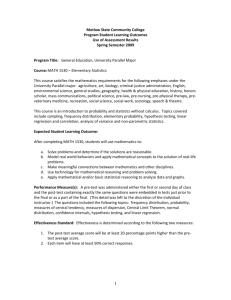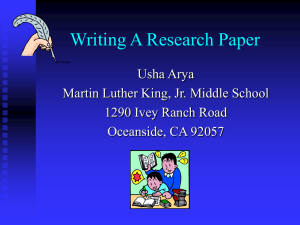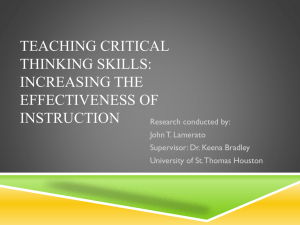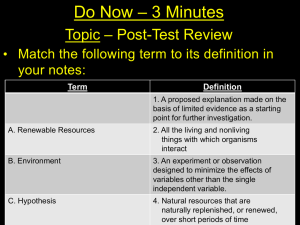Program Student Learning Outcomes USE OF ASSESSMENT
advertisement
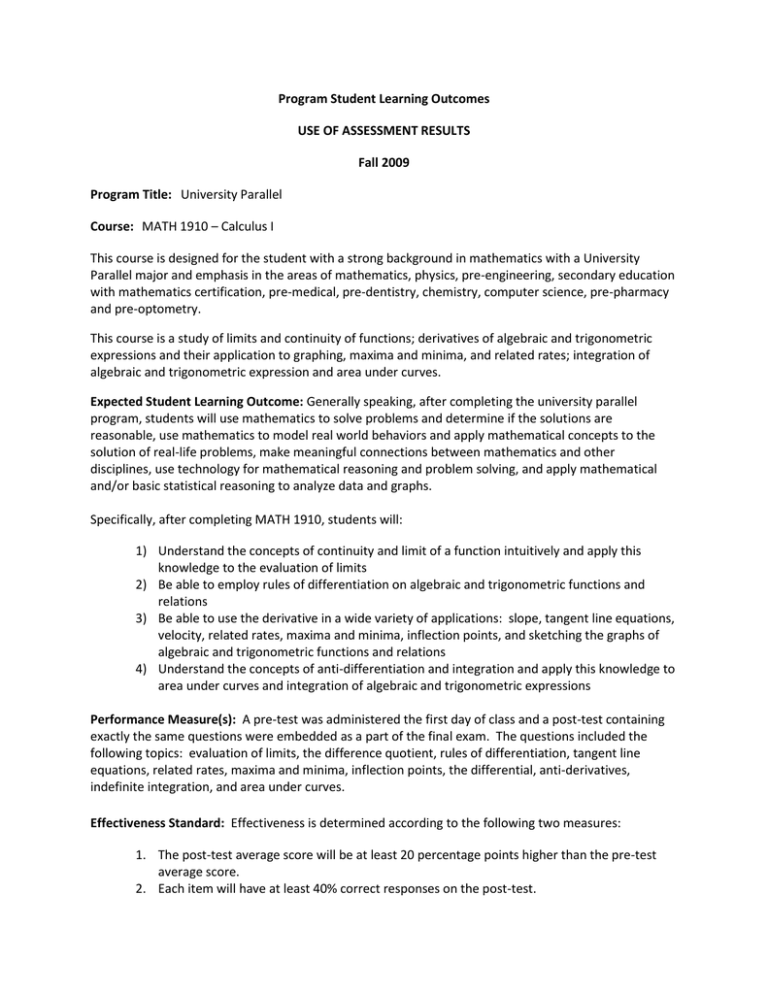
Program Student Learning Outcomes USE OF ASSESSMENT RESULTS Fall 2009 Program Title: University Parallel Course: MATH 1910 – Calculus I This course is designed for the student with a strong background in mathematics with a University Parallel major and emphasis in the areas of mathematics, physics, pre-engineering, secondary education with mathematics certification, pre-medical, pre-dentistry, chemistry, computer science, pre-pharmacy and pre-optometry. This course is a study of limits and continuity of functions; derivatives of algebraic and trigonometric expressions and their application to graphing, maxima and minima, and related rates; integration of algebraic and trigonometric expression and area under curves. Expected Student Learning Outcome: Generally speaking, after completing the university parallel program, students will use mathematics to solve problems and determine if the solutions are reasonable, use mathematics to model real world behaviors and apply mathematical concepts to the solution of real-life problems, make meaningful connections between mathematics and other disciplines, use technology for mathematical reasoning and problem solving, and apply mathematical and/or basic statistical reasoning to analyze data and graphs. Specifically, after completing MATH 1910, students will: 1) Understand the concepts of continuity and limit of a function intuitively and apply this knowledge to the evaluation of limits 2) Be able to employ rules of differentiation on algebraic and trigonometric functions and relations 3) Be able to use the derivative in a wide variety of applications: slope, tangent line equations, velocity, related rates, maxima and minima, inflection points, and sketching the graphs of algebraic and trigonometric functions and relations 4) Understand the concepts of anti-differentiation and integration and apply this knowledge to area under curves and integration of algebraic and trigonometric expressions Performance Measure(s): A pre-test was administered the first day of class and a post-test containing exactly the same questions were embedded as a part of the final exam. The questions included the following topics: evaluation of limits, the difference quotient, rules of differentiation, tangent line equations, related rates, maxima and minima, inflection points, the differential, anti-derivatives, indefinite integration, and area under curves. Effectiveness Standard: Effectiveness is determined according to the following two measures: 1. The post-test average score will be at least 20 percentage points higher than the pre-test average score. 2. Each item will have at least 40% correct responses on the post-test. Assessment Results: Results of the pre-test were as follows: Expected Student Learning Outcome Question number Number Missed Percent missed 1 1 1 2 2 2 2 2 2 3 3 3 4 4 4 1 2 3 4 5 6 7 8 9 10 11 12 13 14 15 5 7 5 4 5 5 6 5 5 1 5 6 5 2 71% 86% 100% 71% 57% 71% 71% 86% 71% 71% 14% 71% 86% 71% 29% 6 Results of the post-test were as follows: Expected Student Learning Outcome Question number Number Missed Percent missed 1 1 1 2 2 2 2 2 2 3 3 3 4 4 4 1 2 3 4 5 6 7 8 9 10 11 12 13 14 15 1 0 0 6 0 3 2 1 4 4 0 2 1 1 0 14% 0% 0% 86% 0% 43% 29% 14% 57% 57% 0% 29% 14% 14% 0% Seven (7) students took both the pre-test and the post-test. The average of the pre-test scores was 32% and the average of the post-test scores was 78%. Assessment results showed a 46 percentage point gain from pre-test to post-test, thus meeting the effectiveness standard that the post-test average score be at least 20 percentage points higher than the pre-test average score. The effectiveness standard that each item will have at least 40% correct responses on the post-test was met by all problems except question 4, which more than 60% of the students answered incorrectly. This question concerns the use of differentiation rules on algebraic and trigonometric functions. Use of Assessment Results: The use of differentiation rules was identified by the post-test as an area which needs more emphasis the next time MATH 1910 is taught. This topic was addressed by question 4 on the post-test and it is the only question that was missed by more than 60% of the students. Faculty will begin to put more emphasis on this area so that when MATH 1910 is assessed in fall 2011, according to the assessment cycle, gains will be made in student learning.

